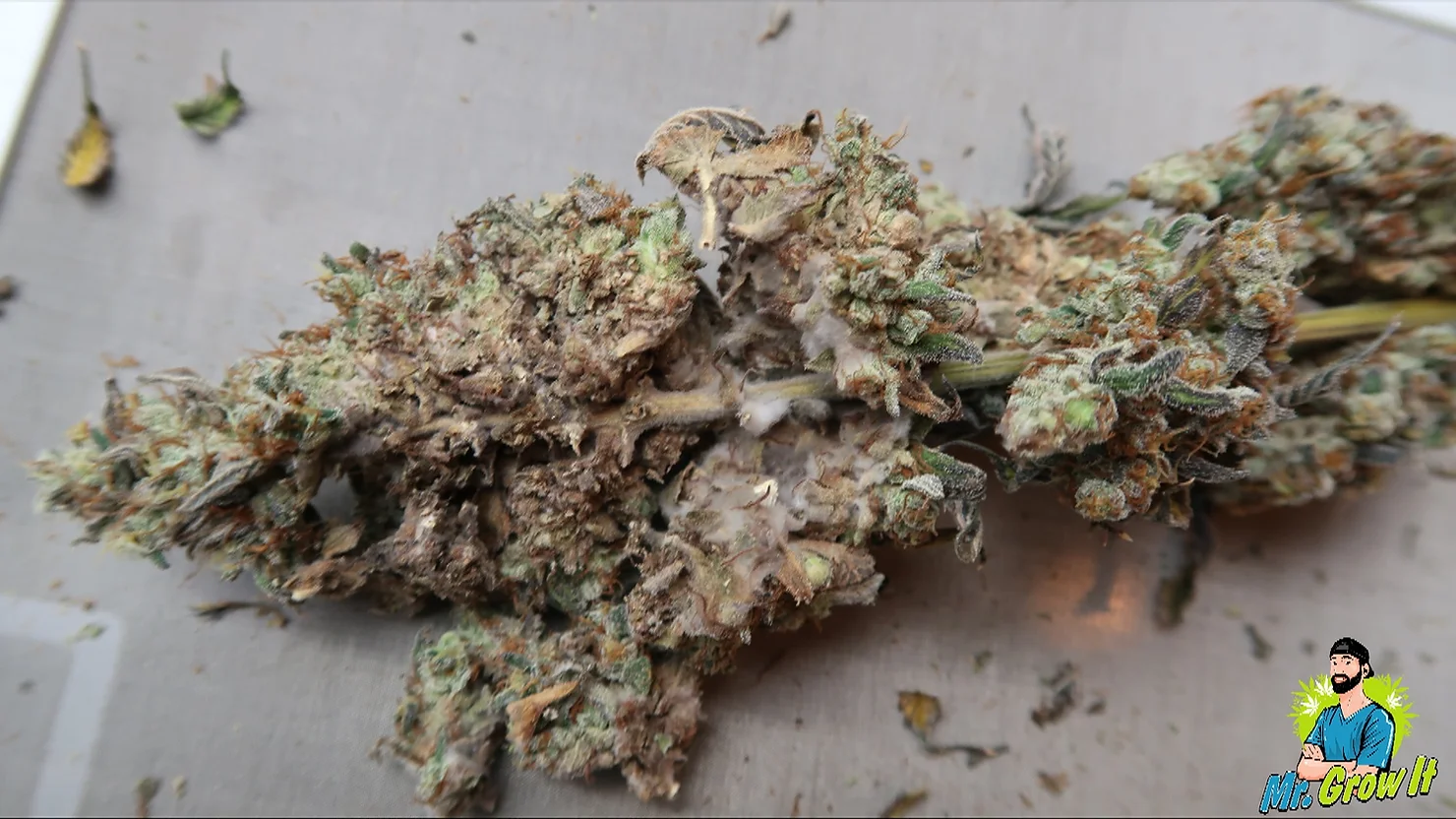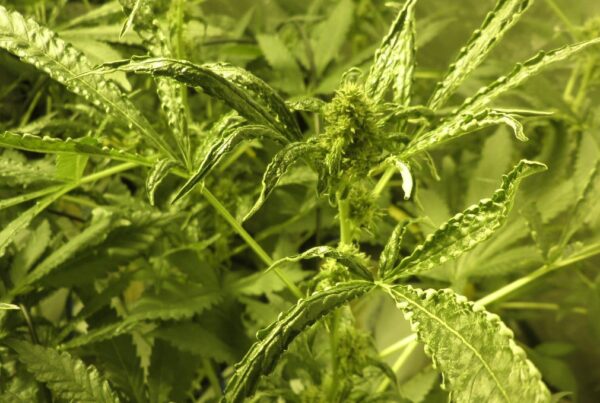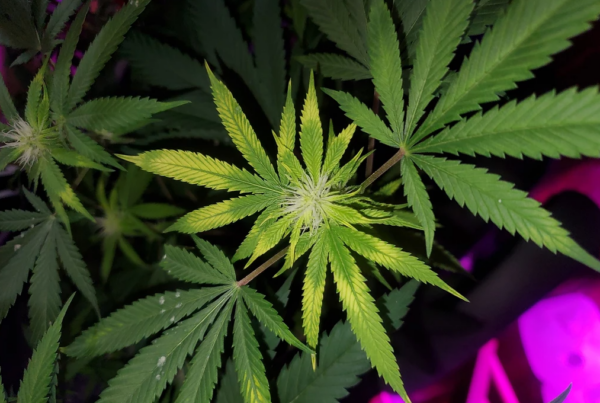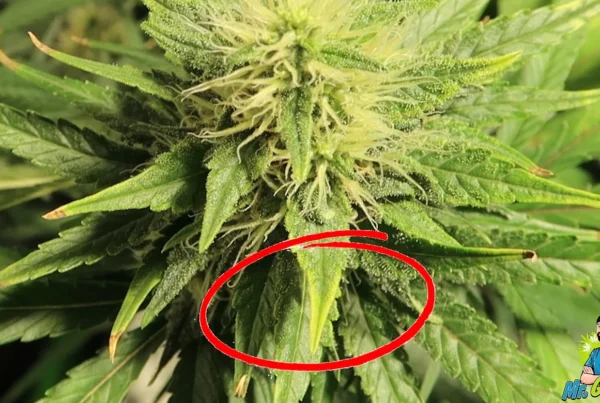One of the worst things that can happen during your grow, is for mold to form on your buds. As the mold grows, the buds rot from the inside out. Since this problem is well hidden within the buds, bud rot could happen without you even realizing it. It could then spread and wipe out your entire crop.
What Is Bud Rot?
Bud rot is caused by a type of fungus known as botrytis cinerea. It is a necrotrophic fungus that affects many plant species with its most notable host being wine grapes. You may also have heard people refer to it as “botrytis bunch rot”, “botrytis blight”, “grey mould”, or “gray mold”. Bud rot is a mold that develops within the colas of cannabis buds. It starts inside the bud, on the stem, and then spreads outwards in all directions. This makes it very difficult to detect.
As it’s breaking down the surrounding buds and spreading out, it produces its own spores that can easily spread to other parts of the plant – or to other plants in your garden. It first appears white and then transitions to grey then black and the bud becomes mushy and slimy.
What Causes Bud Rot?
It’s important to note that mold spores are virtually everywhere. Although, it will only impact your plant under certain conditions. Wet conditions, stagnant air, and a high temperature is the recipe for bud rot. If your RH (relative humidity) is above 60%, you are at risk. That’s one of the main reasons why I tell beginner growers not to chase after VPD.

VPD Chart by Pulse
Vapor Pressure Deficit
VPD stands for Vapor Pressure Deficit and there is a VPD chart readily available online that shows what the optimal humidity level is under a specific temperature – leaf surface temperature to be exact. Many advanced growers will aim for the specified VPD number in order to achieve optimal plant growth. Unfortunately, chasing after VPD is extremely risky. According to the Pulse Veg VPD chart, a RH of 60-68% should be maintained for temperatures between 73-82°F/22-27°C. Remember, a humidity level above 60% poses risk for bud rot. If trying to achieve ideal VPD levels, sufficient air circulation and ventilation is crucial.
Which brings us to another contributing factor to bud rot, stagnant air. If the air in your grow environment is not only humid, but stagnant as well, then there is a higher risk for bud rot. There should always be plenty of air circulation in your grow environment – above the plants, below the plants, and through the plants. When I encountered bud rot, I only had one fan in my grow tent which actually malfunctioned and turned off completely. My plants then sat in that stagnant, humid air overnight and mold started to form.
A 6” oscillating fan moves air very well, and I’ve gone through many grows with just one fan blowing air around a grow tent. In some past grows, I’ve also had a 12” oscillating fan, but not this grow. Moving forward, I will always have at least two oscillating fans in my grow environment – just in case one fails.
The temperature is the last ingredient in this recipe for disaster. Mold grows best in temperatures above 75°F/24°C. Although, mold will also grow in cooler environments but doesn’t grow as quickly. In my particular case, the temperature was around 75°F/24°C when the botrytis first developed. Looking back, it’s no surprise that the top, main colas on all of my plants were impacted. The temperature, humidity, and lack of airflow created the perfect environment for mold to grow within the plants large, dense colas.
Tips To Prevent Bud Rot
- Train your plants so there isn’t one large main cola. I didn’t train any of the plants that were in my grow tent at the time, and the large main colas were the only ones impacted. If I had trained my plants so all colas were the same size (therefore a bit smaller), that may have prevented the mold from forming.
- Prune your plants. The leaves on your plants are constantly adding moisture through a process called transpiration. If you do pruning techniques such as defoliation and/or lollipopping, that will help reduce moisture and will allow more airflow through your plants.
- Keep an eye on the leaves coming from the buds. If those leaves seem to turn yellow overnight, that could be a sign of botrytis. Investigate any colas with yellowing leaves as soon as possible. The leaves turn yellow because they don’t have enough chlorophyll to maintain their healthy green color. If there’s mold, the leaves will basically be falling out and mold or brown spots will be visible in the middle of the cola.
- Set up alerts. I use a temperature and humidity monitor which alerts me through my smartphone if the temperature or humidity is outside of their proper ranges. This can be especially useful to ensure mold growth conditions aren’t present.
- Keep your plants healthy. Bud rot is more likely to hit if your plants are suffering from nutrient deficiencies. According to Leafly, “plants with healthy immune systems are more likely to fend off mold growth. Growing organically with the use of compost tea and diverse nutrients can help increase beneficial microbes in the soil that help keep the immune systems of your plants strong and ready to fight against infection.”
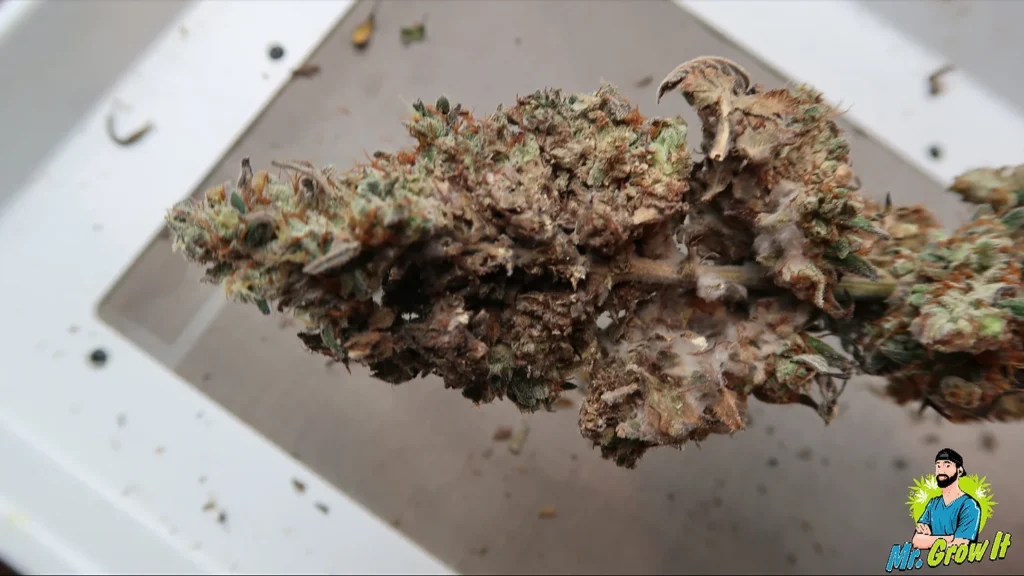
What To Do If You Find Mold
Once the mold starts to form, the buds impacted are no longer safe to consume and must be thrown out. Remove all affected buds immediately while saving what is unaffected. Most growers will inspect their plant by carefully opening up colas to see if any white or grey mold is present. In some cases, the infection is so widespread that the entire plant, or multiple plants in the garden, need to be disposed of. Mold can also occur as the buds dry and cure so be sure to check for signs of mold growth during those processes as well.
Conclusion
To sum things up, botrytis cinerea is a mold that forms within the colas of cannabis buds. It starts inside the bud and then spreads outward. It thrives under certain conditions – high humidity, stagnant air, and high temperature. Proper air circulation, training your plants, pruning your plants, and keeping your plants healthy throughout their entire life can help reduce the chances of bud rot forming. You can also get a device to alert you if the temperature or humidity is outside of their proper ranges and look for yellowing leaves coming from bud sites. If you encounter bud rot, dispose of any buds affected while keeping the buds that were not affected.
![]()

